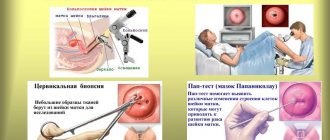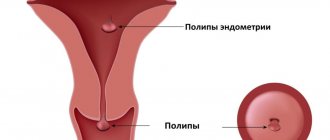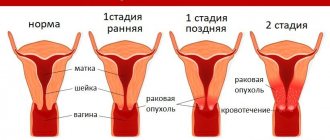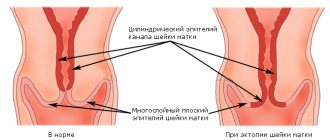In the structure of gynecological pathology, acute and chronic cervicitis occupies a significant place. They occur in 35% of the adult female population. This pathology significantly affects the quality of life and has serious consequences in the absence of adequate pharmacotherapy. The disease also occurs in pregnant women, threatening the normal embryogenesis of the unborn child.
The main task of the gynecological service has become a timely diagnostic search for inflammatory reactions of any location that can lead to infection of the cervix. But screening activities have not yet covered the entire female population. Only understanding the symptoms of the disease will allow a woman to promptly identify her pathology and seek help.
Cervicitis - what is it?
Cervicitis is considered a complication of diseases of the lower reproductive system.
Vulvovaginitis, urethritis, and then cervicitis become successive stages of one inflammatory reaction. Endocervicitis and ectocervicitis are two forms of inflammation of the epithelial cover of the cervical canal of the uterus. The disease is characterized by the transient or permanent presence of infection on the mucous wall, which can progress and become aggressive or malignant. According to the International Classification of Diseases (ICD 10), ICD code N72 belongs to various forms of inflammatory reaction in the cervix. Due to its high prevalence, every woman should have an idea of what cervicitis is, how to identify and treat this disease. Untreated cervicitis in time means chronic erosion, ectopia and oncological tumors in the future. Cervicitis of the cervix can be suspected independently, but treatment should be carried out by a qualified obstetrician-gynecologist.
Preventive measures
To prevent the cervical mucosa from turning red, a woman should:
- try not to expose your genitals to sudden temperature changes;
- Stop using any hygiene products that contain potential allergens. We are talking primarily about odorous substances and alcohol;
- wear loose underwear made of natural fabric;
- wash regularly;
- do not forget about charging;
- eat more vegetables to prevent constipation;
- stop eating fatty, salty and spicy foods. You will also have to exclude alcohol, coffee, strongly brewed tea and sweets;
Hyperemia of the uterine cervix often does not manifest itself or has vague symptoms. That is why, in order to detect it in time, you need to be checked annually by a gynecologist.
Hyperemia may not seem like a serious problem. However, if this “frivolous” problem is not dealt with, it can lead to serious illnesses. Therefore, at the first signs of it, you should urgently go to the doctor.
Every woman wants to be healthy, but women's health in the genital area is perhaps the most vulnerable place. According to statistics, various inflammatory processes in the cervix occur in every third woman of childbearing age.
This is facilitated by various infections and a woman’s lack of attention to her health, and simply ignoring a routine medical examination, because often such inflammatory processes are asymptomatic and can only be detected during an examination by a doctor.
Inflammatory processes in the cervix can be triggered by various reasons and occur in different forms. But all such pathological processes are united by one name: “cervicitis”.
Causes
The main etiological factor of the disease is infectious invasions by bacteria, fungi and viruses. STD pathogens account for 70% of all cases, 20% are infectious-inflammatory reactions caused by opportunistic microorganisms, and only 10% are due to other causes. Although STD pathogens are transmitted through sexual contact, cervicitis cannot occur in men; this form of the inflammatory process occurs only in women.
The main pathogens contributing to the occurrence of cervicitis:
- pathogens of latent sexually transmitted infections;
- opportunistic coccobacillary flora;
- viral strains and protozoa;
- The Candida family of fungi and other types of fungi.
Cervicitis during pregnancy is caused by identical pathogenic agents. Pregnant women who already have a history of mucosal infection may experience reinfection and the addition of a new pathogen.
The causes of cervicitis are not always infectious. Some forms of damage to the cervical canal develop with endocrinopathies, when the natural hormonal balance is disrupted. Such forms of the disease are especially typical in postmenopausal women, when active hormonal changes in the body are underway. Another endocrine disease that can cause cervicitis is diabetes mellitus. Disorders of carbohydrate metabolism entail a change in blood flow in the microvasculature of the epithelial lining. Adequate oxygenation and tissue trophism are disrupted, which entails a decrease in the local immune response.
Manifestations and symptoms
The clinical picture of the disease depends on the type of pathogen that caused it. At an early stage with moderate cervicitis, the woman does not feel any changes in her condition.
The only sign of trouble is an increase in the volume of vaginal discharge. As the disease progresses, cervicitis manifests its symptoms more clearly. The discharge becomes purulent, acquires an unpleasant odor, and pain appears, as a result of which the woman turns to a gynecologist.
How does inflammation of the cervix manifest itself - the main symptoms:
- Pain in the lower abdomen, in the perineum;
- Dyspareunia (pain during intimate contact);
- Burning when urinating;
- Itching and burning in the vagina, on the external genitalia;
- Bloody inclusions in vaginal discharge after sexual intercourse, gynecological examination;
- Bloody discharge not associated with menstruation.
When it becomes chronic, the main signs of the disease weaken, the discharge acquires a mucous consistency and becomes cloudy.
When examining the patient, the gynecologist observes the following symptoms:
- Hyperemia of the pharynx of the cervical canal;
- Swelling and protrusion of the mucous membrane;
- Looseness of the neck and ulceration in herpetic cervicitis;
- “Strawberry cervix” (small hemorrhages on the cervix) due to infection with Trichomonas;
- Condylomas and small ulcers with cervicitis caused by HPV;
- Compaction of the cervix, pseudo-erosions on the mucous membrane, infiltrates, cysts in the chronic form of cervicitis.
When inflammation spreads beyond the cervix, symptoms of concomitant diseases are observed.
Kinds
The main clinical classification of the disease involves dividing the pathology depending on the etiology of the pathogen that caused the inflammation.
According to this modern classification, cervicitis is divided into:
- bacterial cervicitis - caused by absolutely any microbes. They can be transmitted through sexual intercourse or enter the cervical canal from the vagina and environment;
- candidomycosis - infection with fungal microflora or active growth of own candida fungi, which are always present in the urogenital tract;
- viral - infection by virions, while any virus is considered an obligate pathogen, because healthy people do not have a single viral invasion;
- other forms of cervicitis - this category includes other rare forms of the disease (cystic, lymphocytic-infiltrative, endocrine, etc.)
All pathogens that cause cervicitis develop an active inflammatory process in the body. They colonize the mucous membranes, multiply here and lead to cell death. Due to severe destruction of the cellular lining, previous cervicitis can lead to ectopia. Ectopia is a pathological growth of the epithelium beyond the cervical canal. Cervicitis and subsequent ectopia are risk factors for oncogenic and neoplastic processes. This pathological transformation is characteristic of most viral invasions.
Purulent
This form of the disease is characterized by an aggressive course and a tendency to complications. The most common forms of purulent-inflammatory disease are caused by diplococci, myco- and ureaplasma and coccobacillary association of bacteria. In 45% of cases, acute gonorrheal cervicitis occurs with copious purulent discharge, often developing into a chronic recurrent form. The danger of this disease is manifested in the development of cervical ectopia of the cervix following chronic cervicitis, which is characterized by the spreading of epithelial cells beyond the anatomical boundaries of the cervix.
Cystic
Under the influence of various factors, especially infectious ones, the normal functioning of the glandular cells of the cervix is disrupted. Normally, they secrete a special mucus-like substance that protects the genital tract from pathogens. Cystic cervicitis appears due to blockage of the excretory duct of the gland by desquamated and dying epithelium. The natural secretory function is disrupted, and the gland itself swells, forming a cystic cavity. Such cervicitis of the cervix has a tendency to recur. Moreover, local protection against pathogens is reduced, and the reproductive system becomes vulnerable to various pathogens.
Bacterial
Bacterial cervicitis is a consequence of the invasion of pathogenic microbes into the lumen of the cervix from the vagina. In 80% of cases it is caused by STD pathogens, and in the remaining 20% - by microorganisms living in the urogenital tract. An ascending infection causes classic signs of an infectious-inflammatory reaction in the cervical canal: hyperemia, swelling and soreness. As the process becomes chronic, the symptoms subside, reminding themselves only when immunity decreases and the pathological process is activated. Inflammation of bacterial etiology can develop into purulent cervicitis in women, and therefore requires immediate pharmacotherapy.
Lymphocytic follicular
This form is characterized by the formation of infiltrative foci under the epithelial lining of the endocervix. Follicular cervicitis appears in postmenopausal women, so many experts associate this proliferative disease with changes in the concentration of hormones circulating in the blood. The endocervix is actively populated with lymphocytes, which can merge and form small clusters. The disease does not manifest itself clinically in any way, and the diagnosis is established only histologically. Lymphocytic cervicitis is considered by some doctors as a protective reaction to an infectious pathogen that was not detected by standard laboratory tests.
Atrophic
Atrophic cervicitis of the cervix is caused by natural fluctuations in hormone concentrations in the premenopausal and postmenopausal periods. A decrease in the content of estrogen in the blood leads to a proportional decrease in their effect on the epithelial cells of the reproductive system. With normal hormonal balance, active processes of proliferation and division occur, ensuring the correct histological structure of the mucous membrane. Due to a lack of hormones, degenerative and atrophic processes occur, leading to thinning of the epithelial lining, and then nonspecific atrophic cervicitis develops.
Viral
The etiological factor in inflammation is a virus. The pathogen penetrates into the epithelial cell, actively multiplies in it and causes destruction of the epithelium. The clinical symptom complex depends on the strain of the pathogen. Thus, HSV type 2 causes typical herpetic lesions in the form of painful and itchy blisters, which leave ulcerative elements on the mucous membrane. HPV leads to the formation of benign skin tumors - papillomas and condylomas, and CMV and EBV infections can exist for a long time without a single symptom.
Symptoms of cervicitis
Symptoms and signs of inflammation can be both pronounced and hidden.
Signs of uterine inflammation are as follows:
- Painful sensations in the lower abdomen. Such pains are predominantly aching and pulling in nature. They are similar to period pain. The severity of such pain depends on the individual characteristics of the female body, because everyone has a different pain threshold, and on the severity of the disease.
- Discharge mixed with pus or mucus. Such discharge can also be strong or barely noticeable.
- Pain when urinating.
- Discomfort and pain during sexual intercourse.
Such signs of the disease can be detected by the woman herself. When examined by a doctor, an experienced doctor will visually determine the following signs of inflammation of the uterus:
- Redness of the cervix.
- Loose cervix.
- Swelling of the mucous membrane of the cervical canal.
- Small ulcers and hemorrhages of the organ mucosa.
The severity of the symptoms of this disease also completely depends on the pathogen that provoked the disease. This is how the disease caused by gonococci develops most violently and clearly.
In this case, all of the above symptoms will be very pronounced, and it is simply unrealistic not to notice the pathological process in the female body.
There will be pain and discharge and hyperemia of the cervix . Gonococci are the cause of a loose cervix.
But if the disease is caused by chlamydia, then the symptoms will not be so pronounced: they will be weak, or the disease may be completely asymptomatic.
Trichomonas manifest themselves in the form of small ulcers and hemorrhages on the mucous membrane of the cervical canal.
If the pathology is caused by a herpetic virus, then upon examination a bright hyperemia of the cervix with many ulcers and hemorrhages of the mucous membrane is visualized.
Forms of flow
Gynecological classification involves dividing the disease according to the degree of activity and duration of symptoms into several options:
- Acute cervicitis - the duration of the disease is no more than two months;
- Subacute - the duration of the inflammatory reaction is from two to six months;
- Chronic recurrent active cervicitis is a chronic process in the relapse stage, and the number of relapses per year is more than two;
- Moderate chronic cervicitis is the stage of attenuation of the symptoms of the disease; the total number of exacerbations per year is 1-2;
- Inactive chronic cervicitis - the diagnosis is confirmed by laboratory tests, clinical symptoms have been absent for more than a year.
Complications and consequences
The most dangerous complication of the acute phase is the spread of an infectious-inflammatory reaction to the endometrium, uterine appendages and pelvic fat. In the absence of adequate pharmacotherapy, the formation of purulent foci in the small pelvis in the form of abscesses, phlegmons or swellings is possible.
Endometritis, in turn, can progress to endomyometritis and panmetritis with the involvement of all layers of the uterus in the pathological process. A rare complication is sepsis due to the pathogen entering the bloodstream. This condition is life-threatening. Sepsis occurs with multiple lesions of all vital organs and systems.
The consequences of any long-term invasion, especially viral ones, are characterized by cellular transformation in response to a constant inflammatory response. Cervical ectopia and erosion in chronic cervicitis are the most common complications. Cervical erosion and viral cervicitis lead to oncogenic transformation of the epithelium, first causing precancerous changes and then obligate oncological processes.
Treatment of cervical pseudo-erosion
In the absence of complaints and severe symptoms, treatment is not required; regular observation by an obstetrician-gynecologist is sufficient to prevent complications. In case of infection, etiotropic therapy is carried out according to indications. A woman should limit the use of hormonal and some barrier contraceptives (caps). If ectopia is manifested by discharge, abdominal pain, and is characterized by abnormal growth of stratified epithelium, pseudo-erosion is coagulated using various methods:
- Diathermocoagulation.
Cauterization of the area with columnar epithelium is carried out by thermal exposure to electric current. It is characterized by mediocre effectiveness (75-90%) and a number of complications - bleeding, stenosis of the cervical canal with the development of infertility. Prohibited for the treatment of ectopia in nulliparous women. - Laser destruction.
Carbon dioxide or helium-neon lasers are used, the efficiency is very high - 98-100%. - Cryodestruction.
Freezing of the abnormal area with liquid nitrogen, followed by healing and epithelization. The method is widely used due to its simplicity; the effectiveness is 87-95%. - Chemical coagulation.
Based on the traumatic effects of various compounds and pharmacological agents. Can be used in combination with other methods of treating cervical pseudo-erosion to increase their effectiveness.
Symptoms
Acute cervicitis has clear symptoms of an infectious-inflammatory reaction.
With severe inflammation, general infectious-toxic symptoms may appear. The manifestation of the disease begins with a slight pain syndrome in the inguinal-pubic region. As the disease progresses, the dull pain intensifies, and the main signs of cervicitis are added - pathological discharge of various types and acute pain when changing body position, sexual intercourse and physical activity. In some cases, symptoms of cervicitis include light spotting.
In 65% of patients, there is a delay in monthly menstrual bleeding or various variants of its disturbance: oligomenorrhea, polymenorrhea, algomenorrhea. Discharge from cervicitis often has a foul odor due to the presence of pyogenic bacteria in the discharge. Infectious-toxic symptoms of cervicitis are represented by low-grade fever, muscle and headache and general malaise.
Chronic cervicitis in the remission stage can occur latently, and sometimes the only symptom complex is menstrual irregularity. Exacerbation of cervicitis of the cervix has typical symptoms of acute inflammation, but their severity is much less.
Symptoms of cervical inflammation
Clinical signs of cervical inflammation depend on the type of infection that provoked it, as well as the location of its localization. The pathological process may be limited to the mucous membrane of the cervical canal; when the infection spreads deeper, the disease acquires signs of diffuse inflammation.
Inflammation is initially localized in the superficial layer of the cervical canal. The mucous membrane thickens, and the glands located in it begin to produce large amounts of secretion. Over time, the epithelium increases in volume due to inflammatory edema and becomes loose. If at this stage the infectious inflammation of the cervical canal is not eliminated, the microbes penetrate into the deeper layers, and the healing (regeneration) process begins on the surface of the mucosa. As a result, the clinical manifestations of cervical inflammation subside, creating a false feeling of “recovery”, thus forming chronic inflammation.
The most reliable symptom of an infectious-inflammatory process on the cervix is pathological discharge from the vagina. Acute inflammation of the cervical canal provokes profuse purulent (with specific inflammation) or serous-purulent leucorrhoea, which may be accompanied by a feeling of discomfort in the vagina. In a chronic process, leucorrhoea may be scanty or absent altogether, as occurs with chlamydial infection of the genital tract.
Acute purulent inflammation of the cervix during pregnancy poses a threat to the fetus, since the specific infection is very aggressive and can ascend into the uterus. Nonspecific inflammation of the cervix during pregnancy also poses a threat, because if it appears in the early stages, it can provoke disruption of fetal development, and in a later period can cause infectious complications during childbirth.
Inflammation of the cervix is a leading cause of “frozen pregnancy”.
Chronic inflammation of the cervix can cause infertility, since long-term infection changes the properties of cervical mucus and prevents the upward movement of sperm.
Inflammatory changes in the cervix are clearly visualized during a gynecological examination and are characterized by:
- hyperemia and thickening of the mucous membrane of the neck, it looks loose and heterogeneous;
- profuse purulent or serous-purulent leucorrhoea in acute inflammation, in case of chronic inflammation it is scanty and cloudy in appearance;
- eroded areas or ulcers on the mucosa surrounding the external pharynx;
- pinpoint hemorrhages on the surface of the cervix;
- accompanying inflammatory changes in the vagina (hyperemia, edema, pathological deposits on the walls);
- Nabothian cysts, formed as a result of incorrect healing of erosions and ulcers on the surface of the cervix.
Severe inflammation of the cervix of a specific origin does not cause diagnostic difficulties. With trichomoniasis, many pinpoint hemorrhages form on the surface of the cervix, and the cervix becomes like a strawberry. With herpetic lesions of the mucous membranes, the cervix takes on the appearance of continuous erosion due to numerous small ulcers.
Colposcopy is performed for any form of the disease and allows you to determine the presence of characteristic signs of inflammation of the cervix: increase in size, swelling, small cysts. Signs of a background process are often identified in the form of erosion, pseudo-erosion, and so on.
Laboratory diagnostics are necessary to identify the causative agent of inflammation and include examination for sexually transmitted infections, bacteriological examination and study of the microbial composition of the contents of the vagina and cervical canal.
In some cases, the cause of cervical inflammation cannot be determined. As a rule, this happens if the body has coped with the infection on its own, leaving minor changes, which are detected during the examination.
Diagnostics
Clinical and laboratory examination data aimed at identifying the type and strain of the pathogen that caused the inflammatory reaction are of decisive importance in making a diagnosis.
General vaginal and urethral smears determine pathological deviations of the microbiocenosis of the urogenital tract, reveal lymphocytic infiltration and the presence of a large amount of desquamated epithelium.
But a general analysis is not enough to identify the pathogen, so the discharge is collected to carry out the following reactions:
- serological reactions with determination of immunoglobulins of various classes;
- polymerase chain reaction and double hybridization reaction;
- cultural examination with bacterial culture and antibiogram.
An oncocytological smear, which is performed on all patients, is of great clinical importance. It identifies atypical cells that have an abnormal structure and can potentially lead to cervical cancer.
Specific echo signs of chronic or acute cervicitis are usually absent. However, ultrasound examination allows for differential diagnosis with suppurative complications, endometritis, salpingo-oophoritis and other diseases of the reproductive system.
Simple and advanced colposcopic diagnostics make it possible to visualize the mucous membranes of the cervical canal and study its surface in detail. In addition to the presence of pathological discharge, the colposcopic picture is characterized by the presence of many red dots on the surface - these are dilated capillaries. This type of mucosa is specific for an infectious-inflammatory reaction, which is manifested by hyperemia and congestion of the microcirculatory bed.
If these methods are insufficiently informative, biological material is collected for histological and morphological examination of the cervical epithelium. The search is aimed at identifying atrophy, dysplasia, hyperplasia and neoplasia of epithelial cells.
Treatment options
Treatment for hyperemia depends on the specific disease that caused it. The woman will need:
- use pharmaceuticals to heal wounds if redness is caused by mechanical injuries to the uterus;
- use antihistamines if the cause of the pathology is an allergic reaction;
- get rid of erosions or varicose veins if the cervix is hyperemic precisely because of these diseases;
- take antifungal, antiviral or antibacterial medications if the redness is caused by infections;
- treat lung or heart diseases if hyperemia is caused by increased hemoglobin;
- take antihistamines (Suprastin, Claritin) or drugs that improve blood microcirculation (Persantin, Curantil) if the pathology is caused by swelling.
Is it possible to get pregnant with chronic cervicitis?
Most patients with the disease are interested in whether or not it is possible to become pregnant with chronic cervicitis. With this disease, there is no violation of the anatomical integrity and patency of the cervical canal. Sperm have no obstacles to meeting the egg, so the formation of a zygote is possible.
The main problem becomes the task of bearing a healthy child in the presence of a chronic infectious focus. Cervicitis of any etiology during pregnancy is a potential threat to the normal development and growth of the fetus. Cervicitis during pregnancy is subject to mandatory drug treatment, which helps prevent disturbances in embryonic development in the fetus.
Whether it is possible to become pregnant with tuberculous cervicitis is a controversial question. The ability to conceive depends on the adhesive process localized in the reproductive system. With significant adhesions, the patency of the genital tract is impaired, which prevents the reunification of reproductive gametes and the process of conception. For women with active adhesions, it is possible to use assisted reproductive technologies, in particular, in vitro fertilization (IVF).
Treatment during pregnancy
If there is a history of chronic cervicitis and pregnancy has occurred, then the main task of the obstetrician-gynecologist is to suppress the active infectious-inflammatory process and maintain constant remission for nine months.
Treatment of cervicitis in women during pregnancy must meet safety criteria not only for the mother, but also for the fetus. Some antimicrobial drugs can cause embryogenesis stigmata and developmental abnormalities in a child, so their use is prohibited. There is a special list of medications approved for use during pregnancy. These medications are absolutely safe and approved by all medical communities. In addition, pharmacotherapy requires mandatory monitoring of the condition of the expectant mother and her child.
Drug therapy is carried out according to the generally accepted scheme:
- etiotropic pharmacotherapy;
- symptomatic treatment;
- immunomodulation and increasing the immune resistance of the body as a whole.
V. Precancerous diseases of the cervix
According to the literature, cervical cancer ranks third among malignant diseases of the reproductive system in women. Every year, up to 500,000 new cases of cervical cancer are registered worldwide.
But cancer does not appear at lightning speed; decades pass before precancer turns into a malignant process. It can be prevented if precancerous changes are diagnosed and treated in time.
The difficulty in diagnosis lies in the fact that even a pronounced process is asymptomatic, which is why it is so important to be examined by a gynecologist at least once a year.
Many studies prove that the formation of precancerous processes begins with infection with the human papillomavirus, which subsequently disrupts the structural structure of cells, most affecting the cell nuclei.
Condylomas
According to the Bethesda system classification, they are classified as LSIL (low-grade squamous intraepithelial lesions).
Condylomas arise as a result of papillomavirus infection and are growths of connective tissue covered with stratified squamous epithelium.
There are genital and flat condylomas.
In 10% of cases, flat condylomas can become malignant within 2 years; they are invisible to the naked eye and are diagnosed during extended colposcopy.
Treatment of condylomas consists of laser surgery of the affected lesions with further antiviral and immunomodulatory therapy.
Mild dysplasia (CIN I)
Changes in cell structure affect only the lower layers of stratified squamous epithelium.
As a rule, these changes arise as a result of the inflammatory process and either disappear after anti-inflammatory therapy or regress on their own.
In 10-15% of cases they can develop into moderate dysplasia.
Moderate dysplasia (CIN II)
They are characterized by the fact that changes in cells affect higher layers.
In 20% of cases it progresses to CIN III, and in 5% it can develop into cervical cancer.
Severe dysplasia (CIN III) and carcinoma in situ
In CIN III, changes in cells are characterized by the appearance of large nuclei or several nuclei in all layers of the mucosa. Only in the most superficial layers can signs of maturation and differentiation of normal cells be detected.
In case of cancer in situ, the cells do not differ in structure from cancer cells, but these changes have not yet spread beyond the mucous membrane.
Considering that different degrees of dysplasia can be combined, to clarify the stage and before treatment, it is necessary to carry out a targeted biopsy of suspicious areas followed by histological examination.
Treatment
For CIN I-II, treatment begins with anti-inflammatory drugs, followed by repeated cytological examination after 2 weeks.
Also, if a human papillomavirus infection is detected, antiviral and immunomodulatory therapy can be used in combination.
If the changes persist during repeated examination, laser coagulation of the cervix is performed as the most effective method of treatment.
This is an outpatient procedure performed on days 4-7 of the cycle. Complete epithelization of the coagulated surface occurs 4-6 weeks after the procedure.
Subsequently, dynamic observation with cytological examination is necessary every 6 months.
In case of CIN III and cancer in situ, wait-and-see tactics are unacceptable; it is necessary to immediately carry out conization of the cervix - amputation of the cervix followed by histological examination of the material.
The procedure is performed in a hospital under general anesthesia. In this case, you can use various techniques: radio wave, laser, electrosurgical or simply surgical.
The disadvantage of the laser technique is that the edges of the material become charred, which complicates further diagnosis, but the risk of bleeding is much lower than after using the surgical method.
In recent years, the radio wave or argon plasma method has been widely used using a special loop, which eliminates both of these disadvantages.
After the manipulation, clinical observation is also necessary once every 3 months.
More information about cervical dysplasia: classification, causes, symptoms, diagnosis and treatment.
Treatment
Acute and chronic cervicitis require complex treatment prescribed taking into account the individual and age characteristics of the patient.
How long the disease is treated depends on the form, prevalence and activity of the inflammatory reaction. The average duration of a course of pharmacotherapy ranges from 7 to 15 days. Antibiotics for cervicitis are first-line drugs in case of bacterial invasion, and in case of inflammation of viral etiology, antiviral pharmacotherapy is prescribed. To remove inflammation, local therapy is prescribed using vaginal suppositories and creams. If the patient suffers from severe pain that interferes with normal functioning, then a course of nonsteroidal anti-inflammatory drugs (NSAIDs) is prescribed. Antibacterial drugs have the ability to suppress the growth of normal microbial communities of the genital organs, which contributes to the development of candidomycosis. To prevent this condition, Fluconazole is prescribed.
It is impossible to cure chronic cervicitis, but you can influence its activity and the frequency of relapses. During remission, vitamin-mineral complexes and immunostimulants, probiotic and prebiotic medications are prescribed. In case of relapse of the disease, pharmacotherapy is carried out according to the generally accepted scheme for the treatment of acute endocervicitis, with preference given to local dosage forms (ointment forms, vaginal suppositories).
Tablets and ointments
Tablet forms have a number of advantages: ease of administration for the patient, high efficiency and bioavailability, good and rapid therapeutic effect.
The main antibacterial drugs used for drug therapy in women:
- Amoxicillin and its “protected” derivatives (Amoxiclav);
- Second and third generation cephalosporins (Cefazolin, Ceftriaxone);
- Fluoroquinolone pharmaceuticals (Norfloxacin, Oflosacin);
- Tetracycline and its newer derivative, Doxycycline;
- Macrolides (Azithromycin, Roxithromycin, Josamycin);
- Aminoglycosides (Kanamycin, Gentamicin, Sisamycin).
Drug treatment includes the mandatory use of local forms that directly affect the pathological focus. This therapy helps to quickly destroy the pathogen, accelerate the processes of repair of damaged epithelium and reduce symptoms of discomfort.
Candles
Candles (suppositories) for cervicitis with an antimicrobial or antifungal agent are not inferior in effectiveness to systemic antibiotic therapy. Sometimes they are prescribed as monotherapy, but in most cases they are used in conjunction with tablet forms.
The main types of suppositories used in gynecology for local therapy:
- One-component suppositories - Hexicon, Ginezol, Milagin, Pimafucin, Metronidazole;
- Combined - Terzhinan, Betadine, Neo-Penotran.
Betadine and Terzhinan for cervicitis make it possible to simultaneously influence infectious foci of polymicrobial etiology or for any type of mixed infection. Suppositories are inserted into the vagina at night after hygiene procedures with a special instrument sold along with them. It is forbidden to insert suppositories with your hands, this will avoid new infections.
Treatment of inflammation
Treatment of cervical inflammation is prescribed by the doctor individually based on the results of the examination. Antibiotics, drugs to strengthen the immune system, and vitamins are prescribed. Baths with hydrogen peroxide and silver are used to disinfect the inflamed area, douching has a disinfecting effect.
Note:
Endocervicitis is associated with the penetration of infection into the branched system of glands of the mucous membrane of the cervical canal, so the disease becomes protracted; antibacterial drugs are not always effective against microbes located deep in the tissues.
Radio wave treatment is used. Using high-frequency radio waves, the affected tissue is destroyed without affecting adjacent, healthy areas. The procedure is painless and allows you to cope with inflammation in 1 session. In this case, no scars remain on the cervix and there is no bleeding. At the same time, the sexual partner should be treated for infection.
Treatment of concomitant diseases is carried out: cervical erosion, endometritis and others. When treating inflammation in pregnant women, measures are taken to maintain pregnancy and prepare for childbirth.
Traditional methods of treatment
Use only under medical supervision. Infusions and decoctions of plants are prepared for treatment. They can be drunk and also used for douching. Such remedies are used in combination with drug treatment prescribed by a doctor, otherwise the disease may return after the end of herbal treatment.
Decoction for oral administration
Compound:
Eucalyptus leaf, alder cones, yarrow herb - 1 part each Tansy flowers, juniper berries, birch buds, sage - 2 parts each
Application:
All components are mixed. 2 tbsp. l. the mixture is poured with 1/4 liter of boiling water. After 5 minutes of boiling, the broth is infused for half an hour. You need to drink it 3-4 times a day. Single dose - 70 ml. Treatment is carried out for 1-3 months.
Decoction for douching
20 g of sage are boiled in 2 glasses of water for 10 minutes, left for several hours, diluted with 2 glasses of warm boiled water. Douching is carried out in the morning and evening. Chamomile and calendula decoctions are also used.
For purulent cervicitis, a decoction of oak bark is used: 15 g of bark is boiled for 10 minutes in 0.5 liters of water.
When women, usually young girls, are diagnosed with cervical erosion, they may experience completely different emotions. Some people think it’s cancer, and she only has a little time left to live, not to mention having children. Others, having asked their friends, “turn a blind eye” to this very erosion, because It turns out that almost everyone familiar with the female environment suffered from it.
Treatment with folk remedies
Treatment of cervicitis is also possible with folk remedies. Traditional methods, as a rule, complement pharmacotherapy prescribed by a doctor. The use of such methods requires prior consultation and approval of the attending physician. Endocervicitis and its treatment with folk remedies should be carried out only with medicinal substances with strict adherence to the proportions and concentrations of the active substances. Otherwise, the pathological process may worsen and complications may arise.
Treatment of endocervicitis and ectocervicitis with folk remedies can be carried out using the following publicly available methods:
- Carry out douching at home using water decoctions at room temperature. For this purpose, prepare a decoction from special pharmaceutical medicinal herbal infusions or collect medicinal plants yourself. Chamomile, sage, oak bark, buckthorn, and coltsfoot have pronounced therapeutic properties. Douching is carried out with a solution with a temperature identical to body temperature (maximum 38 ºC). It should be remembered that this method is not suitable for people predisposed to allergic diseases.
- Herbal tinctures and teas from lingonberry leaves and berries, dill seeds, chamomile, rose hips or mint. Drinking plenty of fluids allows you to quickly remove endotoxins from the body, reducing the symptoms of intoxication and inflammatory reaction. In addition, these herbal mixtures have a significant uroseptic effect on the urogenital tract, killing pathogenic microorganisms.
Chronic cervicitis also involves treatment with folk remedies. To prevent relapses of the disease, it is recommended to conduct two or three courses of uroseptic herbal medicine per year.
Prevention and recommendations
To prevent relapses of the disease, it is enough to follow the doctor’s recommendations and take preventive measures:
- Treat immune disorders in a timely manner, eat right, and lead a healthy lifestyle;
- If disturbances in the functioning of the reproductive system occur, do not self-medicate and seek medical advice in a timely manner;
- Use barrier means to protect against sexually transmitted infections (condom);
- Avoid unprotected sex with casual partners;
- Regularly visit a gynecologist for preventive examinations, even in the absence of negative symptoms;
- Observe the rules of intimate hygiene;
- Use only high-quality intrauterine devices and replace them in a timely manner;
- Do not use douching unless necessary; consult a doctor before using it;
- Do not use perfumed intimate hygiene products.
To protect the cervix from injury, the obstetrician-gynecologist must rationally conduct labor, qualitatively suturing cervical ruptures, and correctly perform medical procedures.
https://youtu.be/eIxyUrxEAKs
Prevention
Basic preventive measures should be aimed at identifying, sanitation and pharmacotherapy of foci of chronic infection.
Particular attention is paid to the health of the urinary and reproductive systems, which are closely related anatomically and physiologically. Timely screening diagnostics and preventive medical examinations by a gynecologist guarantee the absence of STDs and other infectious infestations in the patient. Increasing the level of sex education among the population will help stop the spread of latent sexually transmitted infections around the world. Unprotected sex with gonococcal cervicitis and other forms of STDs is prohibited. However, the use of barrier methods also does not guarantee complete safety, therefore, during treatment you should refrain from sexual contact with your sexual partner.
Why does the cervix turn red?
Redness on the cervix may occur when:
- the body becomes infected with some kind of infection;
- mechanical injuries occur. You don't have to fall on your stomach to get them. Injuries may appear after examination by a gynecologist or after sex. Such “traumatic” redness usually does not pose any danger and does not require any treatment. After just a few days it disappears on its own;
- pathological lengthening (elongation) or prolapse (prolapse) of the uterus occurs;
- problems with the heart and blood circulation arise;
- blood vessels are compressed by the neoplasm;
- varicose veins appeared in the pelvic area;
- the pelvic organs are overcooled. This often happens when a woman sits on something cold for a long time;
- the body is overheated. Pathology can, for example, appear if a woman works in any industry in extremely hot conditions;
- the lungs or bronchi “stutter”. If there are problems with these respiratory organs, the level of hemoglobin also usually increases;
- increased blood pressure;
- allergic reaction to hygiene products or any medications;
- hormonal changes occur. That is why hyperemia is typical for pregnant women, maturing teenage girls, as well as women who are about to menstruate or menopause;
- not everything is in order with the blood-forming organs;
- constipation appears. Usually such constipation goes along with intra-abdominal hypertension and congestion in the veins.











